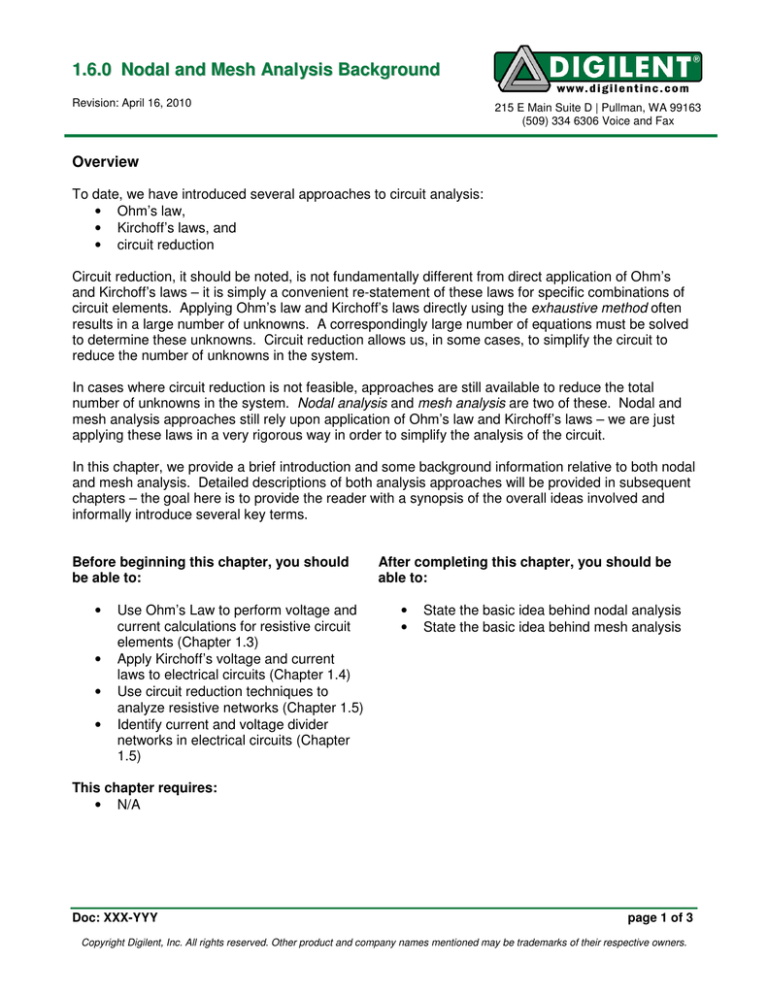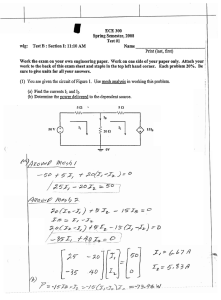
1.6.0 Nodal and Mesh Analysis Background
Revision: April 16, 2010
215 E Main Suite D | Pullman, WA 99163
(509) 334 6306 Voice and Fax
Overview
To date, we have introduced several approaches to circuit analysis:
• Ohm’s law,
• Kirchoff’s laws, and
• circuit reduction
Circuit reduction, it should be noted, is not fundamentally different from direct application of Ohm’s
and Kirchoff’s laws – it is simply a convenient re-statement of these laws for specific combinations of
circuit elements. Applying Ohm’s law and Kirchoff’s laws directly using the exhaustive method often
results in a large number of unknowns. A correspondingly large number of equations must be solved
to determine these unknowns. Circuit reduction allows us, in some cases, to simplify the circuit to
reduce the number of unknowns in the system.
In cases where circuit reduction is not feasible, approaches are still available to reduce the total
number of unknowns in the system. Nodal analysis and mesh analysis are two of these. Nodal and
mesh analysis approaches still rely upon application of Ohm’s law and Kirchoff’s laws – we are just
applying these laws in a very rigorous way in order to simplify the analysis of the circuit.
In this chapter, we provide a brief introduction and some background information relative to both nodal
and mesh analysis. Detailed descriptions of both analysis approaches will be provided in subsequent
chapters – the goal here is to provide the reader with a synopsis of the overall ideas involved and
informally introduce several key terms.
Before beginning this chapter, you should
be able to:
•
•
•
•
Use Ohm’s Law to perform voltage and
current calculations for resistive circuit
elements (Chapter 1.3)
Apply Kirchoff’s voltage and current
laws to electrical circuits (Chapter 1.4)
Use circuit reduction techniques to
analyze resistive networks (Chapter 1.5)
Identify current and voltage divider
networks in electrical circuits (Chapter
1.5)
After completing this chapter, you should be
able to:
•
•
State the basic idea behind nodal analysis
State the basic idea behind mesh analysis
This chapter requires:
• N/A
Doc: XXX-YYY
page 1 of 3
Copyright Digilent, Inc. All rights reserved. Other product and company names mentioned may be trademarks of their respective owners.
1.6.0 Nodal and Mesh Analysis Background
As an example, consider the circuit shown in Figure 1(a). The circuit nodes are labeled in Figure 1(a),
for later convenience. The circuit is not readily analyzed by circuit reduction methods. If the
exhaustive approach toward applying KCL and KVL is taken, the circuit has 10 unknowns (the
voltages and currents of each of the five resistors), as shown in Figure 1(b). Ten circuit equations
must be written to solve for the ten unknowns. Nodal analysis and mesh analysis provide approaches
for defining a reduced number of unknowns and solving for these unknowns. If desired, any other
desired circuit parameters can subsequently be determined from the reduced set of unknowns.
(a) Circuit schematic
(b) Complete set of unknowns
Figure 1. Non-reducible circuit.
In nodal analysis, the unknowns will be node voltages. Node voltages, in this context, are the
independent voltages in the circuit. It will be seen later that the circuit of Figure 1 contains only two
independent voltages – the voltages at nodes b and c. Only two equations need be written and
solved to determine these voltages. Any other circuit parameters can be determined from these two
voltages.
Basic Idea:
In nodal analysis, Kirchoff’s current law is written at each independent voltage node; Ohm’s law is
used to write the currents in terms of the node voltages in the circuit.
In mesh analysis, the unknowns will be mesh currents. Mesh currents are defined only for planar
circuits; planar circuits are circuits which can be drawn in a single plane such that no elements
overlap one another. When a circuit is drawn in a single plane, the circuit will be divided into a
number of distinct areas; the boundary of each area is a mesh of the circuit. A mesh current is the
current flowing around a mesh of the circuit. The circuit of Figure 1 has three meshes:
1. The mesh bounded by VS, node a, and node d
2. the mesh bounded by node a, node c, and node b
3. the mesh bounded by node b, node c, and node d
www.digilentinc.com
page 2 of 3
Copyright Digilent, Inc. All rights reserved. Other product and company names mentioned may be trademarks of their respective owners.
1.6.0 Nodal and Mesh Analysis Background
These three meshes are illustrated schematically in Figure 2. Thus, in a mesh analysis of the circuit
of Figure 1, three equations must be solved in three unknowns (the mesh currents). Any other
desired circuit parameters can be determined from the mesh currents.
Basic Idea:
In mesh analysis, Kirchoff’s voltage law is written around each mesh loop; Ohm’s law is used to
write the voltages in terms of the mesh currents in the circuit. Since KVL is written around closed
loops in the circuit, mesh analysis is sometimes known as loop analysis.
Figure 2. Meshes for circuit of Figure 1.
www.digilentinc.com
page 3 of 3
Copyright Digilent, Inc. All rights reserved. Other product and company names mentioned may be trademarks of their respective owners.


